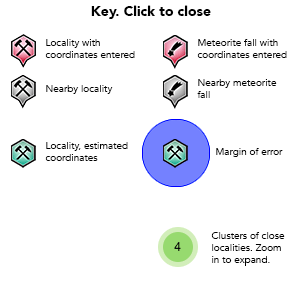Beaton's Hill Gold Mine, Nullagine, East Pilbara Shire, Western Australia, Australia

| Latitude & Longitude (WGS84): | 21° 52' 37'' South , 120° 5' 47'' East |
|---|---|
| Latitude & Longitude (decimal): | -21.87720,120.09661 |
| GeoHash: | G#: qsj7sc7sj |
| Locality type: | Mine |
| Köppen climate type: | BWh : Hot deserts climate |
Alex (Sandy) Beaton was born at Inverness Scotland, and migrated to New South Wales as a young man. He married and had ten children. Trained as a carpenter, then took up land at Grafton, before being run out of the area by a squatter. For a time he worked at carpentry in Adelaide, before leaving his family behind for the Kimberley gold rushes. From here he moved south, and met Nathanial Cooke, who told him about the wonderful gold discovery he had made at Nullagine.
Beaton arrived here and opened up a lease around 1887, later known as Beaton's Hill. The area was said to contain rich gold in wash. Several sources state the lease was rich in gold, including the local warden at the time. A report in 1890 claiming to quote Beaton, stated he had found little gold, while another who knew the man later in life agreed with this also. Beaton was inexperienced at mining, but this was not unusual for early goldfields in Western Australia.
Beaton's four sons, Finlay, Charlie, John and Kenneth, joined him at Nullagine. He sold the lease and the team worked several goldfields in the Mid West Region. Then he purchased a farm at Yandanooka (Mullewa), and the rest of the family joined him from Adelaide.
Several men continued to produce alluvial gold around the base of the hill until the early 1900's. One dray load produced 30 ounces of fine gold. A shaft was sunk for 60 feet on the side of the hill near Louis' Gully, it is said showing gold through the conglomerate the whole distance. The lode was typical of the field being conglomerate and pipe clay, with quartz boulders intermixed forming a pebbly conglomerate, 8 feet wide, 3 inches thick, trending south-west, with some patches exceedingly rich in fine gold.
Gibb-Maitland visited 1908, and states Beaton's Hill is west of Cooke's Hill, the lease being a 4 acres laterite deposit, 10 feet thick, of sandstone and conglomerate near the base of the hill. The bedrock is slate. Alluvial gold was found in a gully to the north. Two shafts had been sunk to 35 and 40 feet depth, but were in a state of dis-repair by 1908. He states there are no official recordings, but this is only because the Mines Department did not keep records until 1898, but he thought ore was carted by horse/dray to a nearby creek, and roughly sluiced, obtaining much gold. Map approximate only.
Commodity List
This is a list of exploitable or exploited mineral commodities recorded at this locality.Mineral List
2 valid minerals.
Rock Types Recorded
Select Rock List Type
Alphabetical List Tree DiagramRegional Geology
This geological map and associated information on rock units at or nearby to the coordinates given for this locality is based on relatively small scale geological maps provided by various national Geological Surveys. This does not necessarily represent the complete geology at this locality but it gives a background for the region in which it is found.
Click on geological units on the map for more information. Click here to view full-screen map on Macrostrat.org
| Neoarchean 2500 - 2800 Ma ID: 734220 | Hardey Formation Age: Neoarchean (2500 - 2800 Ma) Stratigraphic Name: Hardey Formation Description: Sandstone, siltstone, shale, lithic wacke, mudstone, arkose, calcareous beds, conglomerate; porphyry, porphyry breccia; quartzite; dacitic to rhyolitic lavas; quartz-feldspar-mica schist; boulder breccia; basalt; felsic pyroclastics, ultramafic lava. Comments: sedimentary; igneous volcanic; synthesis of multiple published descriptions Lithology: Sedimentary; igneous volcanic Reference: Raymond, O.L., Liu, S., Gallagher, R., Zhang, W., Highet, L.M. Surface Geology of Australia 1:1 million scale dataset 2012 edition. Commonwealth of Australia (Geoscience Australia). [5] |
| Neoarchean 2500 - 2800 Ma ID: 3186668 | Archean sedimentary and volcanic rocks Age: Neoarchean (2500 - 2800 Ma) Stratigraphic Name: Fortescue Group Comments: Pilbara Craton Lithology: Mafic volcanic rocks; shale Reference: Chorlton, L.B. Generalized geology of the world: bedrock domains and major faults in GIS format: a small-scale world geology map with an extended geological attribute database. doi: 10.4095/223767. Geological Survey of Canada, Open File 5529. [154] |
Data and map coding provided by Macrostrat.org, used under Creative Commons Attribution 4.0 License



